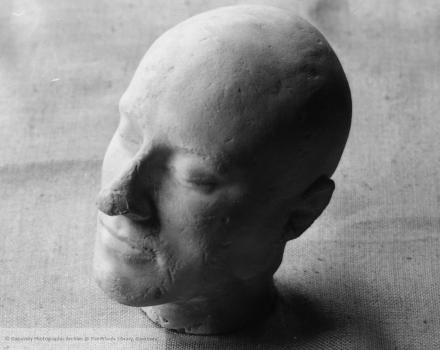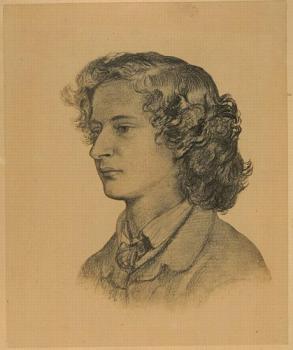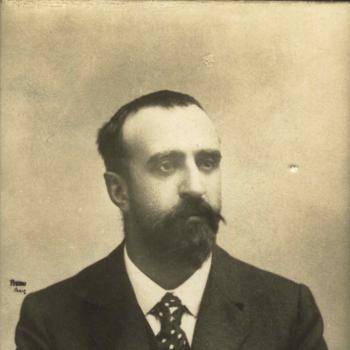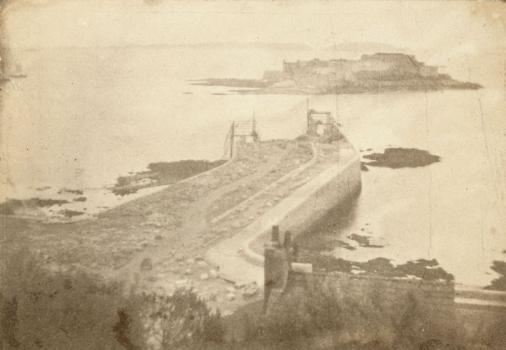22nd March 2019
The poet Algernon Charles Swinburne visited Guernsey and Sark in order to follow in the footsteps of his hero and fellow poet, Victor Hugo. He fell in love with Sark and wrote poems describing his time there, so much so that he declared he would like to be king of the island. The portrait of a young Swinburne is by Rossetti — Swinburne had a mane of flaming red hair. It was drawn in August 1860 (image from the Rossetti Archive from a print held in the Delaware Art Museum). There is a selection of his Guernsey poems with reference to Victor Hugo at the bottom of this page. [By Dinah Bott]
8th March 2019

‘Tu ne tueras pas.’ Pas d’exception. ‘Thou shalt not kill.’ No exceptions. [Victor Hugo, 19 Feb. 1854, Marine Terrace, Jersey]. This death mask was kept by Victor Hugo in the Billiard Room in Hauteville House along with his famous drawing of Tapner, 'Le Pendu,' or 'The Hanged Man.' The Billiard Room was also home to portraits of the Hugo family, other favourite drawings, and maps of meaningful places in Hugo's life. The importance of these memoirs of Tapner to Hugo is thus obvious: they were a permanent reminder of the cruelty of man to man, and of his (for him) abject failure to save Tapner from the scaffold. In addition Hugo blamed himself for Tapner's execution, believing that his ardent intervention had actually been counter-productive - that the French government had pressed upon their British allies not to give in to Hugo's wishes, and that the British had complied. This striking photograph of the mask is by the late Guernsey photographer Carel Toms, taken in 1975, and is part of the Guernsey Photographic Archive held at the Priaulx Library.
6th March 2019
This account of the wreck of the Pourquoi Pas, an event greeted with immense dismay in Guernsey, where Commander Jean-Baptiste Charcot was a great favourite, was kindly written by Cédric Bail, assistant curator at Hauteville House, for the Priaulx Library 'Hauteville House and the Hugo family' exhibition of summer 2018. His original French text is included below.
6th March 2019
Jean-Baptiste Charcot, ‘the Polar Gentleman.’ Doctor, sportsman, Olympic medallist, polar explorer, friend of Captain Scott, and husband of Victor Hugo's grand-daughter Jeanne, this admirable French hero reserved a special place for Guernsey. [By Dinah Bott]
7th November 2018
Once a magnificent farm house with 15 bedrooms, made of the best blue granite, said to be haunted, the old house of the [de] La Marche family in St Martin's saw highs and lows. Its story ended with demolition by the Occupying Forces in 1944, and the memory of the house itself and a reputed connection with Victor Hugo became shrouded in mystery. It is quite possible that Victor Hugo admired the house - he certainly would have admired its wonderful situation, and is quoted as saying (in the advertisement above from a 1915 tourist brochure), 'Live at Icart, live forever!,' but there is no evidence he ever set foot in it. His family, however, were indeed intimately connected with it. [By Dinah Bott]
24th October 2018
Opinions on the building of the Castle Emplacement from Victor Hugo and his son Charles. Charles took the accompanying photograph, The Castle Emplacement under construction, c 1856; he also took a fine study of St Catherine's Breakwater in Jersey some years earlier. (Hugo family friend Auguste Vacquerie was also an excellent photographer, and may possibly be responsible for this photograph, but Charles shared his father's appreciation of the effort and skill required to build these types of structures, and of the progress and growth they embodied, and is likely to have found this and the Jersey breakwater an appealing subject). The photograph is in the collection of Paris Musées: Construction de la digue reliant le château Cornet au port, attribuée à Charles Hugo, 1855-6. [By Dinah Bott]
22nd October 2018
The loss of the paddle-steamer Normandy, 17 March 1870
15th October 2018
The exiled Victor Hugo was forced to leave Jersey very quickly. Here he describes his arrival in Guernsey in a letter to his wife, Adèle Foucher, who had remained for the time in Jersey. The image is from a set of engravings of drawings by Hugo in the Priaulx Library collection.
9th July 2018
'A slightly coloured sketch.'An oaken chest, half eaten by the worm, But richly carved by Anthony of Trent, With Scripture stories from the life of Christ; A chest that came from Venice, and had held The ducal robes of some old ancestor. That by the way—it may be true or false.[From] Rogers’ Italy.By Samuel Elliott Hoskins. Victor Hugo was not, it would seem, the first to transform the carved wooden chests of Guernsey into some other form of decorative furniture. De Beauvoir De Lisle got there before him!
5th July 2018
By Thomas Cave, from the North Devon Journal, September 20 1866. 'It is always interesting to trace the home and associations of an eminent author and to realize a little of the inner life of the man whose works instruct or amuse us, especially when the impress of his mind is so visibly traceable in the material objects about him. It seems as if the fanciful taste which has arranged all these materials at its will in turn receives daily promptings from its very creation.' The engraving of The Oak Gallery is by one of Hugo's favoured artists, Fortune Méaulle, from Alfred Barbou's Victor Hugo and his times, New York: Harper, 1881, in the Library Collection.







